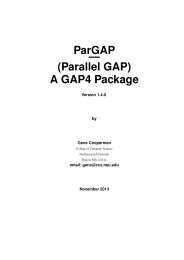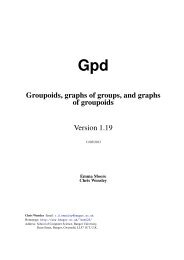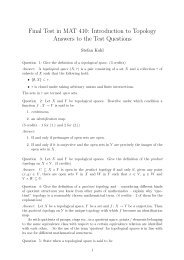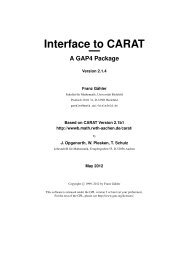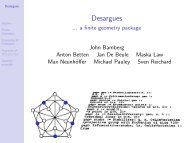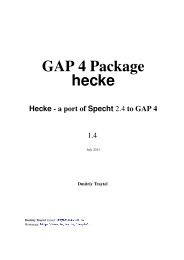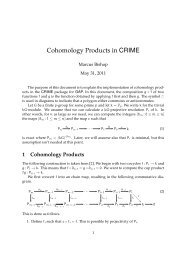guava - Gap
guava - Gap
guava - Gap
Create successful ePaper yourself
Turn your PDF publications into a flip-book with our unique Google optimized e-Paper software.
GUAVA 30<br />
[ 1 1 ]<br />
gap> m*C;<br />
[ 1 1 0 0 ]<br />
4.2.4 InformationWord<br />
♦ InformationWord(C, c)<br />
(function)<br />
Here C is a linear code and c is a codeword in it. The command InformationWord returns<br />
the message word (or ’information digits’) m satisfying c=m*C. This command simply calls Decode,<br />
provided c in C is true. Otherwise, it returns an error.<br />
To invert this, use the encoding function * (see * (4.2.3)).<br />
Example<br />
gap> C:=HammingCode(3);<br />
a linear [7,4,3]1 Hamming (3,2) code over GF(2)<br />
gap> c:=Random(C);<br />
[ 0 0 0 1 1 1 1 ]<br />
gap> InformationWord(C,c);<br />
[ 0 1 1 1 ]<br />
gap> c:=Codeword("1111100");<br />
[ 1 1 1 1 1 0 0 ]<br />
gap> InformationWord(C,c);<br />
"ERROR: codeword must belong to code"<br />
gap> C:=NordstromRobinsonCode();<br />
a (16,256,6)4 Nordstrom-Robinson code over GF(2)<br />
gap> c:=Random(C);<br />
[ 0 0 0 1 0 0 0 1 0 0 1 0 1 1 0 1 ]<br />
gap> InformationWord(C,c);<br />
"ERROR: code must be linear"<br />
4.3 Boolean Functions for Codes<br />
4.3.1 in<br />
♦ in(c, C)<br />
(function)<br />
The command c in C evaluates to ‘true’ if C contains the codeword or list of codewords specified<br />
by c. Of course, c and C must have the same word lengths and base fields.<br />
Example<br />
gap> C:= HammingCode( 2 );; eC:= AsSSortedList( C );<br />
[ [ 0 0 0 ], [ 1 1 1 ] ]<br />
gap> eC[2] in C;<br />
true<br />
gap> [ 0 ] in C;<br />
false






